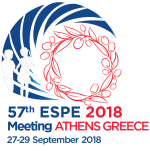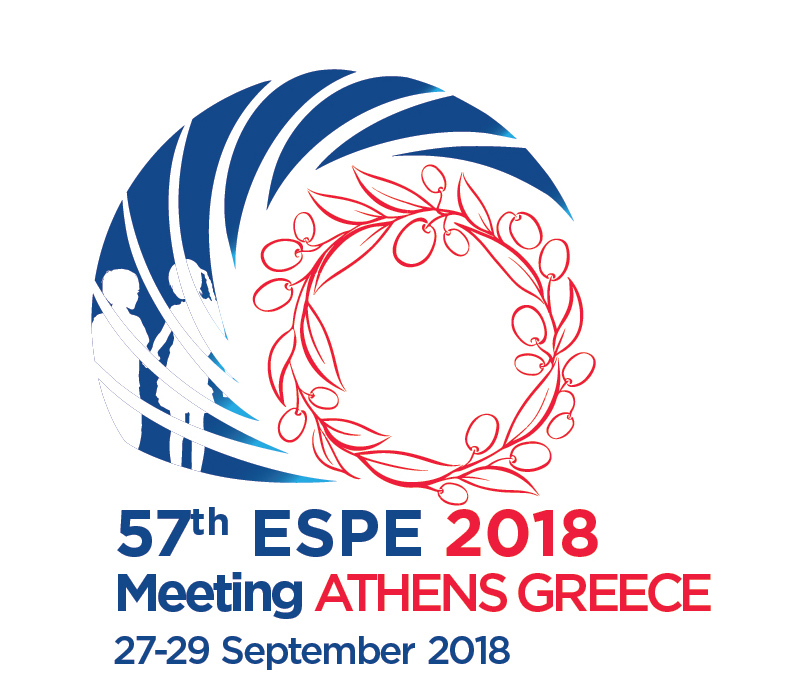
57th Annual ESPE
Athens,
Greece
27 Sep 2018 - 29 Sep 2018

Poster Presentations
Fat, Metabolism and Obesity P3
hrp0089p3-p125 | Fat, Metabolism and Obesity P3 | ESPE2018
NKX2-2 Human Mutation Causes Neonatal Diabetes followed by Severe Infantile Obesity Associated with Paradoxical Upregulated Ghrelin Levels – Do Beta-cells Secrete Ghrelin?
Auerbach Adi , Cohen Amitay , Lavi Eran , Abdulhaq Najwa , Shokrun Ariella Weinberg , Levy-Lahad Ephrat , Hemi Rina , David Zangen
hrp0089p3-p126 | Fat, Metabolism and Obesity P3 | ESPE2018
Tracing the Effect of the Melanocortin-4 Receptor Pathway in Obesity: Study Design and Methodology of the TEMPO Registry
Eneli Ihuoma , Xu Jinyu , Fiedorek Fred , Webster Matthew , McCagg Amy , Ayers Kristin , Ploeg Lex Van Der , Garfield Alastair , Estrada Elizabeth
hrp0089p3-p127 | Fat, Metabolism and Obesity P3 | ESPE2018
BigO: Big Data Against Childhood Obesity
Diou Christos , Ioakeimidis Ioannis , Charmandari Evangelia , Kassari Penio , Lekka Irini , Mars Monica , Bergh Cecilia , Kechadi Tahar , Doyle Gerardine , O'Malley Grace , Heimeier Rachel , Lindroos Anna Karin , Sotiriou Sofoklis , Koukoula Evangelia , Guillen Sergio , Lymperopoulos George , Maglaveras Nicos , Delopoulos Anastasios
hrp0089p3-p128 | Fat, Metabolism and Obesity P3 | ESPE2018
Exposure to Bisphenol-A and Phtalates in Obese Girls
Deodati Annalisa , Bottaro Giorgia , Fintini Danilo , Tait Sabrina , Maranghi Francesca , Busani Luca , Rocca Cinzia La , Tassinari Roberta , Carli Fabrizia , Latta Veronica Della , Buzzigoli Emma , Gastaldelli Amalia , Cianfarani Stefano
hrp0089p3-p129 | Fat, Metabolism and Obesity P3 | ESPE2018
Obesity of Childhood and Ambulatory Glucose Monitorization
Ergur Ayca Torel , Atmaca Berrin , Emeksiz Tuğce Ataseven
hrp0089p3-p130 | Fat, Metabolism and Obesity P3 | ESPE2018
Familial Partial Lipodystrophy, Importance of Family History – A Case Report
Stockley Camilla , Holder Susan , Rangasami Jayanti
hrp0089p3-p131 | Fat, Metabolism and Obesity P3 | ESPE2018
Development of Severe Obesity in a Children with a Brainstem Tumor
Pihoker Catherine , Roth Christian
hrp0089p3-p132 | Fat, Metabolism and Obesity P3 | ESPE2018
Correlation Between Obesity, BMI and Insulin Resistance in Bulgarian Children
Yordanova Desislava , Stefanova Elisaveta , Kazakova Krasimira , Todorova Zdravka , Dimitrova Mihaela , Baycheva Mila
hrp0089p3-p133 | Fat, Metabolism and Obesity P3 | ESPE2018
Nonclassical Manifestation of PWS
Bogova Elena , Volevodz Natalya , Peterkova Valentina
hrp0089p3-p134 | Fat, Metabolism and Obesity P3 | ESPE2018
Metabolic Parameters in Children with Syndromic Obesity
Sukarova-Angelovska Elena , Kocova Mirjana , Krstevska-Konstantinova Marina , Angelkova Natalija , Zorcec Tatjana
hrp0089p3-p135 | Fat, Metabolism and Obesity P3 | ESPE2018
Cut-off for the Follow-up of Obese Children: Cynicism or Realism?
Gallo Francesco , De Quarto Giuditta , Lonero Antonella , Moramarco Fulvio
hrp0089p3-p136 | Fat, Metabolism and Obesity P3 | ESPE2018
Proximal Microdelection 16p11.2 Syndrome
Leo Francesco , Madeo Simona Filomena , Baraldi Alessandro , Predieri Barbara , Stanghellini Ilaria , Calabrese Olga , Iughetti Lorenzo
hrp0089p3-p137 | Fat, Metabolism and Obesity P3 | ESPE2018
The Level of the Vitamin D and Metabolic Status in Children with Obesity
Mikhno Hanna , Solntsava Anzhalika , Dashkevich Helena
hrp0089p3-p138 | Fat, Metabolism and Obesity P3 | ESPE2018
A Compound Heterozygote Mutation in a Chinese Patient Affected with Methylmalonic Acidemia
hrp0089p3-p139 | Fat, Metabolism and Obesity P3 | ESPE2018
Lymposomal Acid Lipase Deficit in Patients with Hypercholesterolemia
Diez-Lopez Ignacio , Sarasua Ainhoa , Lorente Isabel
hrp0089p3-p140 | Fat, Metabolism and Obesity P3 | ESPE2018
Hepatic Steatosis and its Relationship with the Metabolic Syndrome
Angeles Santos Mata Maria , Pilar Fernandez Viseras Irene
hrp0089p3-p141 | Fat, Metabolism and Obesity P3 | ESPE2018
Serum Hepcidin and Ferritin in Prepubertal Obese Children
Gajewska Joanna , Klemarczyk Witold , Ambroszkiewicz Jadwiga , Gła¸b-Jabłońska Ewa , Chełchowska Magdalena
hrp0089p3-p142 | Fat, Metabolism and Obesity P3 | ESPE2018
Osse Registry for Patients with Lipodystrophy Run by the European Consortium of Lipodystrophy (ECLip)
von Schnurbein Julia , Schaaf Jannik , Cecarini Giovanni , Vantyghem Marie-Christine , Vatier Camille , Nagel Gabriele , Araujo-Vilar David , Wabitsch Martin
hrp0089p3-p143 | Fat, Metabolism and Obesity P3 | ESPE2018
Acanthosis Nigricans in Obese Children and Adolescents in relation to Severity of Obesity and Insulin Resistance
Hee Park Kyung , Jung Lim Hyun , Myoung Kim Yoon
hrp0089p3-p144 | Fat, Metabolism and Obesity P3 | ESPE2018
Serum Uric Acid and Its Correlation with Metabolic Syndrome Factors in Simple Obesity Children
Liu Zulin , Liang Liyang , Meng Zhe , Hou Lele , Zhang Lina , Jiang Zhuannan
hrp0089p3-p145 | Fat, Metabolism and Obesity P3 | ESPE2018
Thyroid Function, Lipid Profile and Carbohydrate Metabolism Parameters in Patients with Alstrom Syndrome
Okońska Maja , Brandt Agnieszka , Myśliwiec Małgorzata
hrp0089p3-p146 | Fat, Metabolism and Obesity P3 | ESPE2018
Does the Level of Studies of Parents Influence the Follow-up of the Recommendations of the Nutritional Pyramid?
Rosaura Leis Trabazo Maria , de Lamas Perez Carmela , Vazquez Cobela Rocio , Jose Bedoya Carpente Juan , Olza Meneses Josune , Gil Hernandez Angel , Alberto Moreno Aznar Luis , Bueno Lozano Gloria , Gil Campos Mercedes , Aguilera Garcia Concepcion
hrp0089p3-p147 | Fat, Metabolism and Obesity P3 | ESPE2018
Bariatric Surgery as Treatment of Primary Pseudotumor cerebriin a Male Adolescent: Case Report
Ybarra Marina , Jeronimo dos Santos Tiago , Santos Queiroz Edjane , Rachid Ludmilla , Rocha Franco Ruth , Cominato Louise , Castelo Moura Frederico , Carlos Velhote Manoel , Damiani Durval
hrp0089p3-p148 | Fat, Metabolism and Obesity P3 | ESPE2018
Investigation of Pubertal Effect on Thyroid Volume and IGF-1 Changes in Morbid Obese Children
Karaoglan Murat , Balci Onur , Keskin Mehmet
hrp0089p3-p149 | Fat, Metabolism and Obesity P3 | ESPE2018
The Effect of Vitamin D Supplementation on Metabolic Syndrome Parameters in Overweight and Obese Children and Adolescents in Greece
Giannios Christos , Nicolaides Nicolas , Farakla Ioanna , Papadopoulos Georgios , Gennitsaridi Sofia , Karampatsou Sofia , Kolaitis Gerasimos , Chrousos George , Charmandari Evangelia
hrp0089p3-p150 | Fat, Metabolism and Obesity P3 | ESPE2018
Mother’s Obesity and High Child’s Waist Circumference are Predictive Factors of Severe Child’s Obesity: An Observational Study in French Guiana
Falucar Njuieyon , Emma Cuadro-Alvarez , Elise Martin , Noemie Lachaume , Yajaira Mrsic , Fanny Henaff , Chimene Maniassom , Antoine Defo , Narcisse Elenga
hrp0089p3-p151 | Fat, Metabolism and Obesity P3 | ESPE2018
Lipidogram, Leptin-and Adiponectinaemia in Teenagers and Adolescents with Metabolic Syndrome
hrp0089p3-p152 | Fat, Metabolism and Obesity P3 | ESPE2018
Metabolic Endotoxemia in Egyptian Obese Children and Adolescents
Omar Omneya Magdy , Meheissen Marwa , Zaki Basma , Fattah Magdy Abd El
hrp0089p3-p153 | Fat, Metabolism and Obesity P3 | ESPE2018
Resting Metabolic Rate and the Development of Metabolic Disorders in Obese Children
Okorokov Pavel , Vasyukova Olga , Shiryaeva Tatiana , Peterkova Vanentina
hrp0089p3-p154 | Fat, Metabolism and Obesity P3 | ESPE2018
Relation of Screen-Time (Phone-Computer-TV-Online Games) and Physical Activity with Childhood Obesity
Yılmaz Mehmet Mustafa , İlarslan Nisa Eda Cullas , Gunay Fatih , Yılmaz Ozlem , Ates Funda Seher Ozalp , Kose Serdal Kenan , Atalay Semra , Bilir Pelin
hrp0089p3-p155 | Fat, Metabolism and Obesity P3 | ESPE2018
Effect of Three-Month Diet and Physical Activity on Adipokines and Inflammatory Status in Children with Metabolic syndrome
Stroescu Ramona , Marginean Otilia , Bizerea Teofana , Gafencu Mihai , Doros Gabriela
hrp0089p3-p156 | Fat, Metabolism and Obesity P3 | ESPE2018
Neck Circumference and Lipid Profile in Adolescents with Overweight/Obesity
Arrais Ricardo Fernando , Nunes Amanda Caroline Pereira , Andrade Ana Suely de , Souza Angelica Luiza de Sales , Araujo Eduarda Pontes dos Santos , Soares Erika Aparecida de Araujo , Pimentel Jessica Bastos , Teixeira Suerda Isa Nascimento , Souza Thatyane Oliveira , Jaime Viviane Cassia Barrionuevo , Rezende Adriana Augusto de , Lima Severina Carla Vieira Cunha
hrp0089p3-p157 | Fat, Metabolism and Obesity P3 | ESPE2018
A Not So ‘Simple Obesity’
Poluzzi Silvia , Madeo Simona Filomena , Rossi Gloria , Bruzzi Patrizia , Stanghellini Ilaria , Calabrese Olga , Iughetti Lorenzo
hrp0089p3-p158 | Fat, Metabolism and Obesity P3 | ESPE2018
Effect of Obesity on Bone Age and Hormonal Parameters in Indian Children
Ramachandran Smita , Sethi Aashish , Kochar Inderpal
hrp0089p3-p159 | Fat, Metabolism and Obesity P3 | ESPE2018
Compliance of Obese Children and Their Family to the Directions of a Pediatric Endocrinology Medical Office
Giannopoulou Sotiria , Eliopoulou Maria , Gogos Charalampos
hrp0089p3-p160 | Fat, Metabolism and Obesity P3 | ESPE2018
Risk Factors and Comorbidities of Childhood Obesity
Giannopoulou Sotiria , Eliopoulou Maria , Gogos Charalampos
hrp0089p3-p161 | Fat, Metabolism and Obesity P3 | ESPE2018
Autonomic Nervous System - Inflammation Link: A New Independent Mechanism for Homeostasis
Geronikolou Styliani , Chrousos George , Albanopoulos Konstantinos , Cokkinos Dennis , Kanaka-Gantenbein Christina
hrp0089p3-p162 | Fat, Metabolism and Obesity P3 | ESPE2018
Effects of a Brief Physician Delivered Counseling on Childhood Obesity
Mondal Sunetra , Chatterjee Sudip
hrp0089p3-p163 | Fat, Metabolism and Obesity P3 | ESPE2018
The Prevalence of Obesity in Boys in the Region of the Russian Federation
Larionova Mariya , Kovalenko Tatiana
hrp0089p3-p164 | Fat, Metabolism and Obesity P3 | ESPE2018
Obesity in Adolescents, is Accompanied by a High Levels of Leptin and a Low Serum Ghr Level in the Blood Plasma. A High Degree of Obesity is Accompanied by a Greater Higher Leptin Level and Decrease in the Ghr Level. These Changes are More Significant Registered in Abdominal Ob
hrp0089p3-p165 | Fat, Metabolism and Obesity P3 | ESPE2018
Hidden Hunger in Overweight/obese Indian Adolescents
Jain Vandana , Upadhyaya Babita , Agarwala Anuja
hrp0089p3-p166 | Fat, Metabolism and Obesity P3 | ESPE2018
Assessment of Obesity in Children with Achondroplasia and Hypochondroplasia
Nakano Yukako , Kitaoka Taichi , Takeyari Shinji , Ohata Yasuhisa , Kubota Takuo , Ozono Keiichi
hrp0089p3-p167 | Fat, Metabolism and Obesity P3 | ESPE2018
Correlation of Lipoprotein(a) Levels and Family History of Cardiovascular Disease in a Sample of Overweight/obese Children and Adolescents
Kappou Kalliopi , Bisbinas Vasiliki , Karabouta Zacharoula
hrp0089p3-p168 | Fat, Metabolism and Obesity P3 | ESPE2018
Beneficial Effect of Metformin Treatment in Obese Children and Adolescents
Todorova Zdravka , Stefanova Elissaveta , Kazakova Krassimira , Jordanova Desislava , Dimitrova Mihaela
hrp0089p3-p169 | Fat, Metabolism and Obesity P3 | ESPE2018



